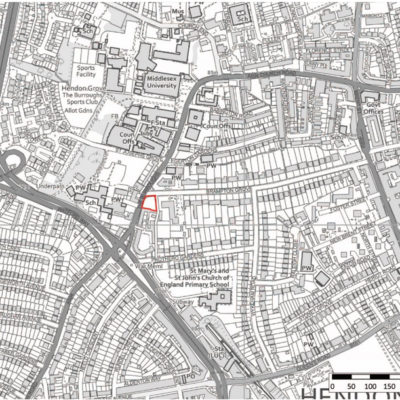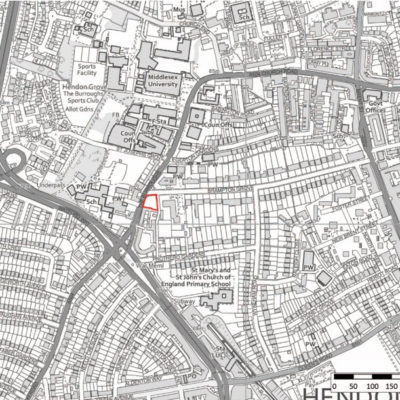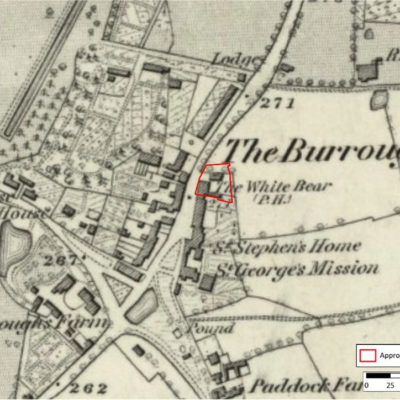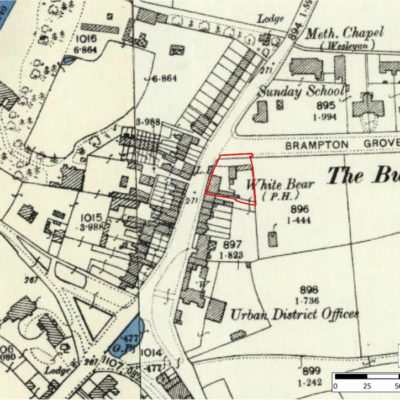Archaeological Desk-Based Assessment, Hendon, London
This Archaeological Desk Based Assessment (ADBA) retrospectively assesses the impact of the development carried out at the site of the former White Bear Public House, Hendon, London.
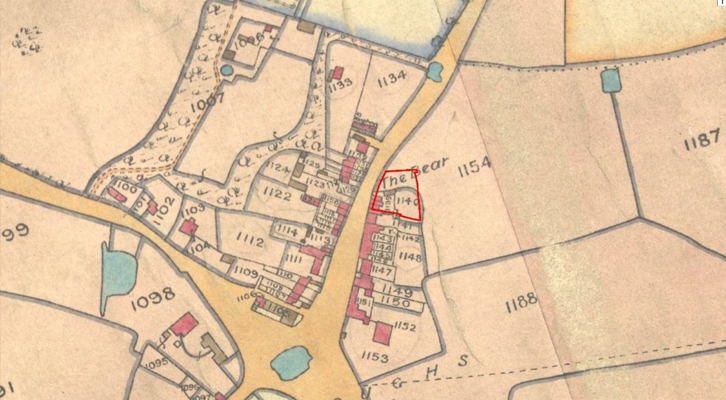
In Brief
Archaeological Desk Based Assessment
Key Points
- There have been no previous archaeological investigations carried out within the site. There have been two investigations in the vicinity of the site. The first 90m south-west of the site recovered pottery dating 10th – 14th century and nine Roman pot sherds. The second was 40m north-west of the site, recovered a Roman cremation jar. All of the other archaeological investigations that have taken place within the study area recorded either Roman, medieval or post-medieval finds.
Summary
This desk- based study assesses the impact of the proposed scheme on cultural heritage assets (archaeological remains). It forms an initial stage of investigation of the area of proposed development (hereafter referred to as ‘the site’) and may be required in relation to the planning process in order that the local planning authority (LPA) can formulate an appropriate response in the light of the impact on any known or possible heritage assets.
The site lies in an Archaeological Priority Area as designated by Barnet Borough Council and which is noted for its Roman and medieval potential. The site also lies in the Burroughs Conservation Area, which has a relatively high concentration of listed and locally listed buildings.
It is considered that prior to the current (proposed) building works taking place, the site had a moderate potential for archaeological survival, owing to some disturbance caused by development in the post-medieval period and during the early 20th century when the White Bear Public House was rebuilt. Outside of the areas of ground disturbance that have taken place during the current buildings works, archaeological potential by period is as follows;
The site has a high potential for remains dating to the post-medieval period. It is highly likely that footings and features associated with buildings seen on early maps (including those from the 1932 building) will remain in areas outside of the current development, around the edges of the site. There may be particular local interest in any finds or features associated with the first White Bear Inn/ alehouse that was located in the north of the site.
The site has a moderate potential for remains dating to the Roman period. There has been known Roman activity within the area, and there have been a number of finds and features dating to the Roman period within close vicinity to the site. However, it is likely that the site lay close to a farmstead or within the land of a larger estate during this period.
The site has a low potential for significant remains dating to the medieval period. While there has been some record of medieval pottery found within close vicinity to the site, it is likely that during this period the site was on the periphery of the early medieval settlement, in open farm or pasture land.
There is a low potential for remains dating to the prehistoric period for within the site. Although the area would have been desirable for early settlement, the search area returned no results for the prehistoric period, and it is likely that earlier development would have removed or severely truncated remains from this period.
In this instance, whereby excavation works have already taken place, any archaeological remains that may have been present within the footprint of the current (proposed) building will have been completely removed or severely truncated by excavation works, reducing the significance to any remains present to negligible or nil. Outside of the areas of the current new (proposed) building may still contain evidence of the post medieval buildings seen on early maps, fronting onto the Burroughs and the first White Bear Inn/ alehouse building to the north of the site.
Results
The site does not contain any nationally designated (protected) heritage assets, such as scheduled monuments, listed buildings or registered parks and gardens. It is within an Archaeological Priority Area and the Burroughs Conservation Area, as designated by Barnet Borough Council.
From historic boreholes taken in the area, it is estimated that there may be between 0.7 – 0.9m of undated (historic) made ground within the site, overlying River Terrace gravels.
The site, prior to current construction, would have had a moderate potential for archaeological survival with a high potential for post-medieval remains. Potential for earlier surviving deposits was in the main, moderate to low, owing to ground disturbance caused by development on the site in the post-medieval period and 20th century. However, owing to the site laying within an APA and considering its proximity to Roman and medieval activity, it would be recommended that an archaeological evaluation takes place prior to initial groundworks.
In this instance, whereby excavation works have already taken place, any archaeological remains that may have been present within the footprint of the current (proposed) building will have been completely removed or severely truncated by excavation works, reducing the significance to any remains present to negligible or nil. Outside of the areas of the current new (proposed) building may still contain evidence of the post medieval buildings seen on early maps, fronting onto the Burroughs and the first White Bear Inn/ alehouse building to the north of the site.

